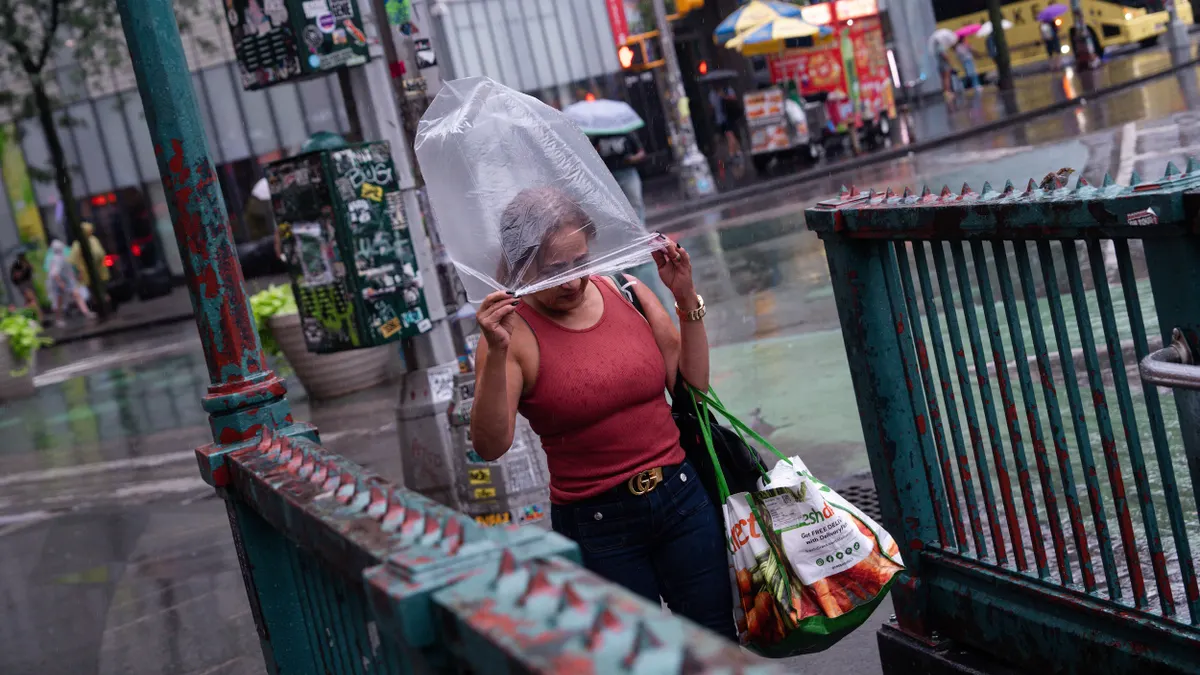Researchers at the National Renewable Energy Lab in Golden, Colorado, are trying to ramp-up clean energy in the U.S. resource mix by developing innovative technology solutions to tricky problems and passing them on to industry.
But the path toward a carbon-free future is littered with roadblocks, including lingering concerns about the intermittency of renewable resources, their potential strain on the electric grid and an administration seeking to roll back renewable research funding.
FORT COLLINS and GOLDEN, COLORADO — Colorado is in many ways a state at odds with itself when it comes to its energy mix, and a reflection of a broader debate about the future of fossil fuels and renewable energy in the United States.
Electricity from renewable sources has more than doubled since 2010 to almost 25% of Colorado's net generation in 2017, led by increased wind power from the state's nearly 2,000 turbines, the U.S. Energy Information Administration reported in January.
However, more than half of Colorado's electricity comes from coal-fired power plants, and annual coal production in the state increased for the first time in six years in 2017 amid rising foreign demand for U.S. coal resources, according to EIA. And Colorado is the fifth largest natural gas producing state, with 11 of the 100 biggest natural gas fields in the United States.
"The climate emergency we're in right now is tied to our use of fossil fuels," said Bryan Wilson, executive director of the Energy Institute at Colorado State University. "On the other hand, the work we're doing with the oil and gas industry right now is primarily around developing solutions that are in the very near term leading to reductions of the environmental footprint, things like methane emissions, but in the long term are helping to enable that transition from fossil fuels to renewables."
The Centennial State is also home to the National Renewable Energy Lab (NREL), to which the Society of Environmental Journalists arranged a field trip during its annual conference in Fort Collins, Colorado, earlier this month. NREL researchers demonstrated a virtual reality analysis of wind speed and flow data gleaned from Eagle, the world's largest supercomputer dedicated to energy efficiency and renewable energy, according to the organization.
"We are in the middle of transforming the energy supply," said Martin Keller, director of NREL and president of the Alliance for Sustainable Energy, the company that operates NREL for the U.S. Department of Energy.
The motivation
Investors and markets are at risk from $2.2 trillion of stranded fossil fuel assets, according to London-based think tank Carbon Tracker.
"On a global scale, for the fossil fuel industry, stranded assets will be a major, major issue," Keller said.
"It’s very trendy right now to say 'we’re going to 100% renewable' and to be honest with you, when I hear that I sometimes cringe a little bit because this is still a very, very heavy lift."

Martin Keller
Director, National Renewable Energy Laboratory
Renewable energy research must accelerate to facilitate the transition, despite declines in the cost of renewables, because "we're just seeing the beginning of a new era in renewables," Keller said. He compared the current status for renewables to when Henry Ford made the first model T. "That's not what you're driving right now."
"Making this transition is also very challenging because ... putting a lot of these intermittent assets on our grid and changing the grid architecture will also bring a lot of issues we don't really know how to deal with," he said. "It's very trendy right now to say 'We're going to 100% renewable,' and to be honest with you, when I hear that I sometimes cringe a little bit because this is still a very, very heavy lift."
The technology
Wind
NREL wind energy researchers contributed to a journal article published in Science on Oct. 10 that identified three key challenges for the wind energy sector: improved understanding of the resource and its flow in the atmosphere where wind plants operate; addressing the structural and system dynamics of the largest rotating machines in the world; and designing and operating wind power plants to support grid reliability.
Nicholas Brunhart-Lupo is a visualization scientist and self-described cave troll at the Energy Systems Integration Facility Insight Center, which works with researchers to "take their data off the supercomputer" and use, look at and interact with that data in new ways because the sheer amount of information makes it easy to "get lost and have no idea what's going on," he said. "It's just trying to help our researchers understand their data a little better."
"Manufacturers ... can come in, use our facilities, work hand and hand with our researchers, take that back to their companies and say ‘all right, let’s do this.’"

Andrew Hudgins
User Program Integrator, Energy Systems Integration Facility, NREL
Brunhart-Lupo demonstrated this approach by allowing one observer to don a special pair of glasses and take a virtual walk into the data set, using natural body motions to navigate through the wind turbine data.
The somewhat-disorienting display of colors has blue representing slow-moving air and yellow representing air rotating very quickly, or "turbulence" that "gets really, really choppy" beyond 300 meters. Wakes emerging from such turbulence can impact turbines' efficiency — preventing it from generating as much energy as its capable of and adversely impacting the structural integrity of those machines.
Steering a turbine rotor to redirect its wake optimization at the plant level may increase U.S. wind power capacity by 2.5 GW, as the Wind Plant Integrated System Design and Engineering model demonstrates.
"We are learning, in a much better way right now, how to build wind farms," Keller said.
"We are learning through high-performance computing, modeling and simulation how a wind turbine affects efficiency of a downstream wind turbine. If you're on a lake and you're driving a boat, you're creating a wake. The same is happening in the atmosphere ... you create some turbulence and this turbulence impacts the downstream wind turbines. We had this problem in the wind parks … some of them lost efficiency. There will be stress on the system, which breaks the gear boxes. You can steer the wake away from downstream turbines."
EVs, storage and more
In 2018, electric vehicles saw strong growth and wound up with a 2.1% market share of new passenger vehicles, nationwide. But the expected surge in EV usage could create major issues for the energy grid. NREL researchers are working to understand that impact and how to make the grid and storage systems more resilient.
"The opportunity for us is understanding how hydrogen can be supported for vehicles, but also energy storage," said Andrew Hudgins, user program integrator at the Energy Systems Integration Facility.
"To do that, we have to scale up the size of hydrogen electrilizers and fuel cells from 150 to 250 kW to 5 to 10 MW," he said. "And to do that, we need more effective and efficient materials going into those fuel cells and improved manufacturing and fabrication."
Improved manufacturing is the big opportunity he sees there. Allowing those manufacturers to use and learn from NREL's facilities is one way those companies, particularly smaller startups without access to those technologies, could pick up efficiencies and ways to lower costs, then bring that information back to their company.
NREL is building out an "extreme fast-charging capability" to support the deployment of 350 kw electric vehicle chargers, he said. "The industry needs to go that way to support faster charging times of light, medium and heavy duty vehicles. But what's the effect on the grid if you aggregate three or four chargers at a site and you have a MW of instantaneous load to charge those vehicles?"
"We're looking at battery chemistries because you can't just change them that quick without understanding what's the effect on the total system," Hudgins added.
Federal funding needs
NREL's business volume by funding source for fiscal year 2018 totaled $410.4 million, representing an increase from $382.7 million in fiscal year 2017. The largest portion — $54.6 million — was directed to a technology partnership agreement/strategic partnership project.
But a renewable energy expansion has also been challenged by the Trump administration's anti-regulatory bent, experts note. Presidential budgets in recent years have proposed eliminating the U.S. Department of Energy's Advanced Research Projects Agency-Energy and substantially cutting DOE's energy efficiency and renewable energy spending, only to have federal legislators step in to restore the funding and then some.
When Keller visits Washington, D.C., he says legislators on both sides of the aisle let him know that they will continue to fund NREL's research efforts, "which is very encouraging for us."
"Funding on renewables in general has gotten fairly broad bipartisan support," Wilson said on the bus ride on the way to the NREL facility. "There are other bad things that have happened on the energy side, but at least on the R&D side it's been pretty good."
The industry partners
NREL researchers aim to bridge the gap between basic science and commercial application — de-risking technological ideals, helping to demonstrate their scalability and partnering with industry to get these ideas into the field, Keller said.
Collaboration with industry "has not been an NREL strong point, but really since Martin [Keller] came that is something that has picked up," Wilson said.
In May, Irving, Texas-based oil major ExxonMobil announced it will invest up to $100 million over 10 years to research and develop advanced lower-emissions technologies with NREL and the National Energy Technology Laboratory. The funding will support research and collaboration into bringing biofuels, carbon capture and storage to commercial scale across the transportation, power generation and industrial sectors, according to a company statement.
NREL is also collaborating with Arizona-based utility Salt River Project on a project to better understand the benefits and impacts of battery energy systems. NREL will assist the utility throughout the three-year program by evaluating battery technologies and interpreting data about customer battery use, according to an NREL statement.
"We have a thermal chamber where we're putting the residential batteries and we can replicate the heat those batteries experience inside a garage in Phoenix so we can do accelerated lifecycle testing, get that data immediately and work with SRP to provide feedback on thermal management systems, other controls and scenarios [such as] when's the best time to use the battery based on the temperature that they experience and the loads they experience at homes," Hudgins said.
While the path toward a 100% renewables is a difficult one, “from a research perspective, it’s a really exciting time,” Keller added. “The key is that we need to continue to drive innovation.”


















